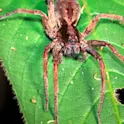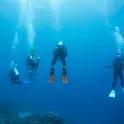
Featured news
08 Jul 2021
Slow music in tunnels can keep drivers focused and safe
Study is proof-of-principle that background music can improve road safety: Frontiers in Psychology

Featured news
08 Jul 2021
Study is proof-of-principle that background music can improve road safety: Frontiers in Psychology

Featured news
07 Jul 2021
Air pollution increases the risk of severe period pain for women and girls: Frontiers in Public Health

Featured news
02 Jul 2021
Microbes in cow stomachs can break down plastics, representing an eco-friendly way to reduce litter: Frontiers in Bioengineering and Biotechnology

Featured news
29 Jun 2021
California’s blue oak woodlands are threatened by hotter and more frequent extreme droughts due to climate change: Frontiers in Climate

Featured news
24 Jun 2021
By Colm Gorey, Frontiers science writer Image: New Africa/Shutterstock.com New research published in the open access journal Frontiers investigating the biological mysteries of sleepwalking found the levels of ‘fight or flight’ response in those who wander at night is surprisingly lower than those who sleep soundly. Somnambulism – otherwise known as sleepwalking – is a phenomenon which has fascinated the public and neurologists for decades, but a lot of what causes it remains a mystery. Affecting up to 4% of adults, sleepwalking is a non-rapid-eye movement (NREM) sleep parasomnia that not only gives someone a poor night’s sleep, but also puts them at serious risk of injury and, in some cases, lead to unintended violence against others. The following day can also prove challenging as the sleepwalker will feel unrested and a strong desire to fall asleep (somnolence). Unfortunately for those predisposed to sleepwalking episodes, prolonged sleep deprivation increases both their frequency and complexity, making it harder for them to achieve the deep sleep the body needs to function healthily. Now, in a paper published to Frontiers in Neurology, researchers at the University of Montréal and Montréal Sacred Heart Hospital, Canada aimed to further investigate the hypothesis that sleepwalking is […]

Featured news
24 Jun 2021
By Colm Gorey, Frontiers science writer/Prof James Serpell, University of Pennsylvania Prof James A Serpell, University of Pennsylvania. Image: University of Pennsylvania Two distinctly different stories have been created to explain how fearsome, wild wolves were first domesticated by humans, according to Prof James A Serpell of the University of Pennsylvania and the Wallis Annenberg PetShape Leadership Institute. However, in the open access journal Frontiers, he recently published a paper investigating the truth of these claims. Despite being considered mankind’s best friend, the ancestors of modern dogs were a lot less welcoming to human owners. However, trying to trace the timeline of when early humans first domesticated wild wolves to serve their needs has proven difficult. One of the most prevalent origin stories in scientific literature suggests the ‘commensal scavenger hypothesis’. This posited that wolves essentially domesticated themselves by invading ancient human settlements in search of animal remains and other edible waste discarded by hunter-gatherers. Over time, tolerance by humans gave a selective advantage to the bolder, less fearful wolves, which then diverged from the ancestral population as they adapted to the new scavenging niche. An alternative hypothesis – sometimes referred to as the pet keeping or cross-species adoption hypothesis […]

Featured news
22 Jun 2021
By Conn Hastings, science writer Image credit: LanaG/Shutterstock.com While scientists have known that PTSD and migraine often co-occur, no one had studied this link before now. A new study by the open access publisher Frontiers on identical twins investigates the genetic basis for both migraine and PTSD. It reveals epigenetic changes that are shared by PTSD and migraine, suggesting that similar environmental risk factors are at play in both conditions. The findings could help researchers to develop new treatments. Post-traumatic stress disorder (PTSD) and migraine often co-occur, but researchers knew relatively little about how or why this happens. A new study in Frontiers in Neuroscience is the first to investigate if the conditions have a common genetic basis. By studying identical twins, where one twin in each pair lives with PTSD or migraines and the other twin does not, the researchers found common genes that may play a role in both conditions. These genes may help to explain why the conditions co-occur, and could reveal new treatment targets for both. PTSD is a psychiatric disorder that typically occurs after a traumatic experience, such as a life-threatening event. Most people will experience a traumatic event at some point in their lives, […]

Featured news
18 Jun 2021
By K.E.D. Coan, science writer Cupiennius salei wandering spider. Image credit: Kevin Wells Photography / Shutterstock.com A recent study by the open access publisher Frontiers shows the first evidence that the individual hair-like structures that form spiders’ adhesive feet are far more diverse than expected. By looking at a sample set of these hairs, researchers have found that they have varied shapes as well as attachment properties. Understanding how spiders climb a wide range of surfaces may help scientists design new and better adhesives. Just how do spiders walk straight up — and even upside-down across — so many different types of surfaces? Answering this question could open up new opportunities for creating powerful, yet reversible, bioinspired adhesives. Scientists have been working to better understand spider feet for the past several decades. Now, a new study in Frontiers in Mechanical Engineering is the first to show that the characteristics of the hair-like structures that form the adhesive feet of one species — the wandering spider Cupiennius salei — are more variable than previously thought. “When we started the experiments, we expected to find a specific angle of best adhesion and similar adhesive properties for all of the individual attachment hairs,” […]

Featured news
16 Jun 2021
Glycophosphate persists within wild plants for at least two years, reducing fertility: Frontiers in Plant Science

Featured news
14 Jun 2021
Novel fish waste treatment system breaks down fish sludge and turns it into fertilizer: Frontiers in Plant Science

Featured news
10 Jun 2021
Functional brain connectivity networks with behavioral relevance are already present in young infants, finds new study in Frontiers in Psychiatry.

Featured news
10 Jun 2021
First study to show gene expression changes in divers with ‘the bends’ show role of genes for inflammation and immunity: Frontiers in Physiology

Featured news
07 Jun 2021
By Mischa Dijkstra, Frontiers science writer / Tal Gordon, George S Wise Faculty of Life Sciences, Tel-Aviv University, Israel Tal Gordon during one of her research dives. Image credit: Tal Zaquin Dr Tal Gordon is a zoologist and molecular biologist interested in the molecular basis of regeneration. She grew up in Eilat (Israel) close to the Red Sea and spent much of her childhood by the sea. Her recent PhD thesis at Tel-Aviv University focused on the development and regeneration in ascidians (sea squirts, a non-monophyletic subdivision of tunicates), in particular Polycarpa mytiligera. She discovered that this species has unique regeneration abilities, which makes it an excellent new model system to study regeneration and stem cells. One key result, recently published in Frontiers in Cell and Developmental Biology, is that P. mytiligera can regenerate any missing body part, including its entire nervous system, by reactivation of evolutionarily conserved developmental programs. Gordon is currently a postdoctoral fellow in the laboratory of Dr Omri Wurtzel at Tel-Aviv University, focusing on the molecular basis of regeneration. In her present research, she uses comparative genomics to unravel regulatory pathways that facilitate ascidian regeneration. As part of our Frontier Scientist series, she told us about […]

Featured news
31 May 2021
Arabic speakers worldwide can now access a library of kid-friendly scientific articles thanks to a newly launched educational resource.

Featured news
31 May 2021
By Tayyibah Aziz, science writer A productive lettuce yield following the researchers’ new biodisinfestation method. Image: Maite Gandariasbeitia et al A new study published by the open access publisher Frontiers has demonstrated that beer bagasse and rapeseed cake can be used as effective biodisinfestation treatments to reduce populations of soil parasites and increase crop yields. Researchers demonstrated that using these organic treatments in soils significantly reduced root-knot nematodes and boosted beneficial soil populations, as well as reducing waste from the agricultural industry by incorporating organic by-products as a treatment instead of harmful chemical fumigants. The use of many chemical fumigants in agriculture have been demonstrated to be harmful to human health and the environment and therefore banned from use. Now, in an effort to reduce waste from the agricultural industry and reduce the amounts of harmful chemicals used, researchers have investigated using organic byproducts from beer production and farming as a potential method to disinfest soils, preserve healthy soil microorganisms and increase crop yields. In this study published to Frontiers in Sustainable Food Systems, researchers from the Neiker Basque Institute for Agricultural Research and Development in Spain investigated using agricultural by-products rapeseed cake and beer bagasse (spent beer grains), along […]
Get the latest research updates, subscribe to our newsletter